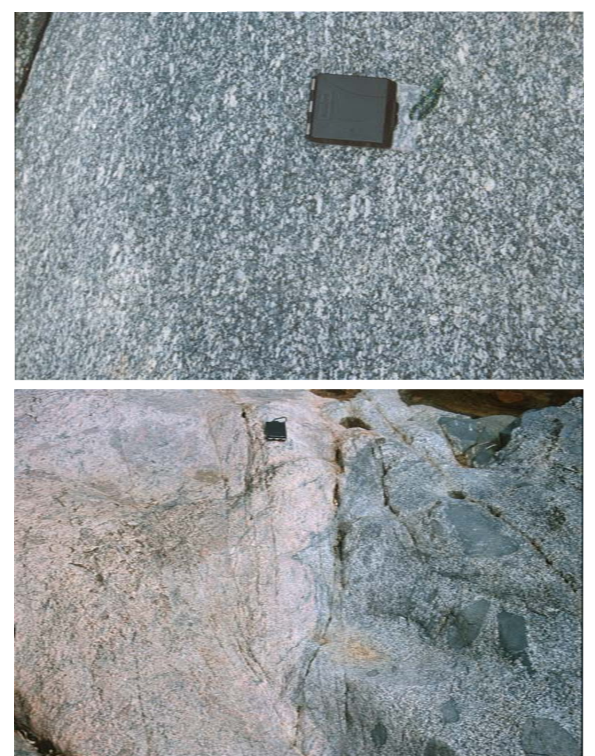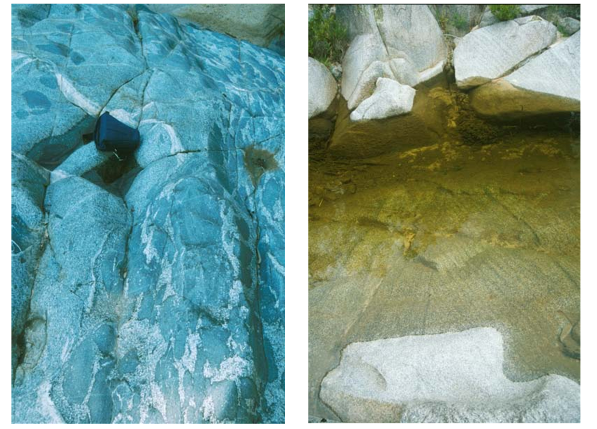Candelo xenolith
This site is possibly one of the most impressive stops of the trip. It represents a zone of accumulation of stoped rock fragments at the interface between the Kameruka and overlying Pericoe plutons. The fragments include metasediments, migmatites, tonalites, diorites and gabbros. The major feature is a large, approximately 120 x 80m xenolith of Candelo Tonalite suspended with in the surrounding Pericoe granite (Figure 21). Not only is this location unique in that the accumulation zone of stoped material is observed, but it can also be placed in stratigraphic context.
Figure 21. Simplified map of the Candelo Block (megaxenolith).

The block is interpreted to be a large fragment of stoped countryrock which has fallen (or slid) through the magma chamber (the Pericoe pluton) and come to rest on the floor of the pluton. The block is surrounded by unusual magmatic features which we believe formed during deposition of the large xenolith.
Pluton Structure
Unlike the highly variable Kameruka pluton, the Pericoe pluton is very homogeneous, has very few mafic enclaves and syn-magmatic mafic dykes, and lacks a magmatic foliation. The contact with the underlying Kameruka Granodiorite is characterised by a ~600m-thick zone of inter-sheeted granites from both pIutons, separated by a number of elongate metasedimentary screens. The zone also contains a complex array of mafic dykes, enclave swarms, metasedimentary xenoliths, highly variable hybrid granite types, and large fragments of granite and diorite. As all of these complex features exist at the base/floor of the Pericoe pluton, it is an excellent example of an 'elephants graveyard', The presence of numerous Kameruka-Pericoe hybrids at the contact suggests a close temporal relation between the two plutons.
The Candelo Tonalite xenolith is located within the abovementioned contact zone, specifically at an interface between Kameruka and Pericoe granites (Figure 21). The tonalite is distinct from the two enclosing granites in that it is finer grained and much more mafic, containing abundant mafic enclaves and conspicuous hornblende grains. The tonalite also lacks the large K-feldspar crystals and rounded quartz grains that are typical of the other plutons. Three of the contacts have been mapped in detail, but the fourth is obscured by vegetation. All of the xenolith contacts are sharp, indicating that the tonalite must have been relatively rigid prior to its incorporation. Nonetheless, ductile shear zones in the tonalite suggest that it was able to deform plastically, and was therefore a semi-viscous block during emplacement. Several lines of evidence support this fragment representing a stoped block, including 1) sharp discordant contacts with host granites 2) angularity of contacts 3) truncation of mafic enclaves at the contact 4) truncation of a weak magmatic flow foliation within the tonalite 5) truncation of two mafic dykes within the block, at the contact 6) both Kameruka-and Pericoe-type dykes cut the tonalite 7) break-up of the tonalite into smaller fragments and incorporation into the host granite
An interesting and fascinating point to note is that the closest outcrop of Candelo Tonalite (in map view) lies some 30-40 km away! Pluton and batholith reconstructions must take this feature into account.
Cross Section through the Candelo Tonalite Megaxenolith
After walking through the base of the Pericoe pluton, a sharp bend in the river is approached. This signifies the beginning of an approximately 500m long section incorporating the Candelo Tonalite xenolith and the very unusual features associated with it.
Granites at the base of the Pericoe pluton are characterised by tabular euhedral plagioclase grains up to 2cm in length surrounded by sub-rounded quartz (I cm), interstitial biotite and small K-feldspar grains. Weak compositional layering, defined by slight variations in grainsize, is aligned approximately parallel to the E-W magmatic flow alignment of enclaves and tabular plagioclase.
Stop A.
The first stop is close to the base of a 15 x l0m gabbroic-diorite fragment surrounded by a tonalitic phase of the Pericoe pluton. The tonalite locally displays an intense foliation (Figure 22a), along the western contact (base) of the fragment (Figure 22a). We interpret the foliation as a compaction fabric caused by sinking of the diorite into a crystal-rich Pericoe mush.
Figure 22ab. Perico granite and felsic material

a) Strongly aligned fabric in Perico granite immediately below a large dioritic xenolith suggesting that the fabric is a compaction fabric. b) Flow zone of felsic material at the base of the Candelo megaxenolith.
Figure 22cd. Enclave swarm and Perico Pluton

c) Strongly aligned enclave swarm at the top of the megaxenolith. d) Cross-bedding in the Perico pluton. The rhythmic layering is defined by variations in biotite with the boundary between layers marked by an enrichment of biotite. A “package” of these layers may terminate at an angle to an overlying “package”. This geometry is similar to trough cross-bedding in sedimentary environments.
Stop B.
Approximately 50m downstream lies the contact between the base of the Candelo megaxenolith and a bounding flow-foliated zone of flow-banded felsic rock, grading to pegmatite (Figure 22b). Locally separating this zone from the underlying granodiorite is a variably flattened enclave swarm hosted in a narrow strip of Pericoe tonalite. The swarm is identical to that overlying the megaxenolith, and for this reason, we suggest that the huge block was emplaced within this (low viscosity?) feature. We can talk about the occurrence of these zones in the Pericoe pluton. Toward the center of the pluton, these enclave swarms are common and define a series of channels!
The felsic, flow-banded zone at the base of the tonalite has a distinct pink colour owing to the high proportion of K-feldspar. The rock itself varies from zones that are fine-grained and biotite-bearing to coarse-grained and biotite-free, which locally grade to pegmatite patches, which are concentrated near the contact with the tonalite xenolith. A very well developed, highly sinuous flow foliation is present throughout the zone, defined by biotite schlieren and zones of grainsize variation. The orientation of the foliation is variable yet sub-parallel to the megaxenolith, probably indicating that this zone was extremely fluid when formed.
We suggest that this "fluidised" felsic rock-type was a crystal-poor magma that originally defined the interface between crystal-rich and crystal-poor zones in the magma chamber. Locally, it can be followed into the underlying granite, as dykes. It resembles some of the layering in the Towamba River (Day 1, Stop 1), where we interpret felsic dykes to have entered the magma chamber. Thus, such felsic units probably represent original floor/chamber interfaces in the pluton, preserved as a result of an unusual disequilibrium process operating at the time. At this stop, we interpret disequilibrium to be fracturing of the underlying crystal-rich magma and ingress of the crystal-poor melt caused by collision of the tonalite megaxenolith onto the floor of the magma chamber.
Stop C.
Approximately 10m into the Candelo tonalite megaxenolith, a 2m wide mafic intermediate dyke can be followed 60m downstream (SE) where it terminates against the Kameruka granodiorite. Mingling features along the margin of the mafic dyke indicate that the dyke is late-plutonic in relation to the Candelo Tonalite. It indicates that the tonalite bock was rigid and intruded by dykes prior to fragmentation and incorporation into the base of the Pericoe pluton. This would be a perfect dyke to sample in order to determine the precise age of magmatism!
Stop D.
At this stop, an interconnected network of granitic dykes can be observed cutting the Candelo Tonalite. The dykes are connected to the surrounding Kameruka granite and vary from megacryst-rich through to aplite. The megacrystic dykes commonly display flow sorting highlighted by the accumulation of K-feldspar megacrysts along their margins. The dykes are commonly associated with small ductile shear zones. An example of shear movement can be seen where an aplitic dyke shows dextral offset along a cross cutting granite dyke. The interconnected network of dykes appears to represent a set of fractures that formed during the early stages of disaggregation of the large xenolith. Between Stops D and E, the proportion of felsic dykes and smaller veins increases dramatically, corresponding with increased proximity to the top of the xenolith. The dyking at this point forms a very complex array with no obvious preferred orientation. They probably represent "backveins" of host material, injected as the top of the megaxenolith began to fracture.
Stop E.
This site is located at the top of the Candelo tonalite, approximately 160m above the base of the xenolith. There, a mafic enclave swarm separates the top of the xenolith from the overlying Pericoe pluton (Figure 22c). The contact with the megaxenolith is sharp yet irregular and trends approximately E-W, then to N-S as it swings around the top of the megaxenolith. Embayments along the contact contain rounded to irregular enclaves, whereas salients contain highly stretched enclaves. Similar features are seen in the enclave swarm at the base. The longest axies of the enclaves form a steep east-plunging lineation. Overall, the degree of elongation decreases away from the xenolith. We interpret these features as indicating that the swarm was magmatic during emplacement of the rigid tonalite block. Enclaves that were localised in embayments around the block were protected from deformation, whereas the salients were most exposed and most deformed against the rigid block during emplacement. Nonetheless, the deformation was ductile rather than brittle, indicating that the host was largely magmatic, consistent with the top of the block having been emplaced into a melt-rich magma chamber.
Between stops E and F, the Kameruka granodiorite, which is in contact with the enclave swarm, grades into Pericoe Adamellite. There a series of compositional layers are preserved, with a structure that resembles sedimentary cross-beds.
Stop F.
Cross bedding in granites? Distinct compositional layers are apparent at this locality, some of which are extremely uniform in thickness (~15 cm), although variations exist. An enrichment of biotite at the base, together with fine-grained tabular plagioclase and a small amount of quartz define each individual layer. The biotite-rich zones grade progressively into biotite-poor zones at the top of each layer, which is enriched in euhedral to subhedral plagioclase, quartz and interstitial K-feldspar. The layers are curvi-planar and some are laterally continuous for at least 20m. The layers are parallel to one another and form sets containing between 10 and 30 layers. Each set of layers is delineated at low angles by other overlying sets (Figure 22d). The overall appearance of the zone is extremely similar to trough cross-bedding preserved in sedimentary environments. The cross-cutting relations between the sets indicates that younging and therefore, the top of the sequence is to the east, the same as that determined for the underlying Kameruka Granodiorite.